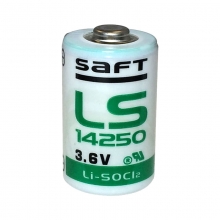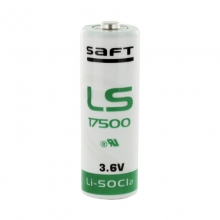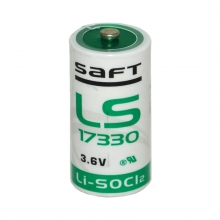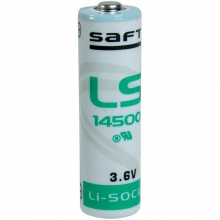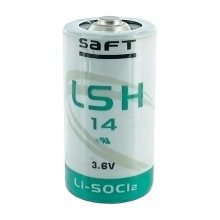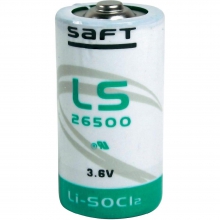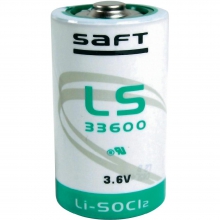Saft lithium Battery LS14250
Saft LS14250 primary lithium cell, is based on the Lithium-Thionyl chloride (Li-SOCl2) chemistry. The LS14250 key features are the concentric electrodes (“bobbin”) construction that enables maximum loading of active materials and corresponding energy.
The LS14250 cell is designed specifically for long-term (3 to 15 years) applications, featuring a few UA based currents and periodic pulses, typically in the 5-150 mA range.
Compatible Part Numbers: 1770-XZ, 3B26, 418-0076, 60-0576-100, 6135-99-770-2535, 6ES5-980-0MA11, 6ES59800MA11, 742-0011, 922-1262, ER3, ER3S, ER4, LS14250, LS3, T04/41, T04/51, TL-2150, TL-2150/S, TL-2151, TL-5101, TL-5112, TL-5151, TL-5151S, TL2150, TL2151, TL5101, TL5112, TL5151, TL5151S, VL1/2AA
Construction Features:
Concentric (“bobbin”) electrodes
Stainless steel containers
Un-fused individual cells
Non-flammable electrolyte
Compliant with IEC 86-4 safety standard and EN 50020 intrinsic safety standard
Underwriters Laboratories (UL) Component Recognition - LS 14250 File Number MH 12609
Main Applications:
Memory back-up
Real-time clocks
Utility metering
Automated meter reading
Wireless alarms and Security devices
Emergency locations transmitters beacon
Electronic toll collection
Professional electronics
Benefits:
High operating voltage, stable during most of the application lifetime
Some of the highest nominal capacities on the market today
Excellent reliability over extended operating life
Operating Temperature Range: -60°C/+85°C (-76°F/+185°F)
Excellent resistance to humid environments
Low magnetic signature
Good resistance to passivation
Non-flammable (and non-pressurized at ambient temperature) inorganic (but corrosive) electrolyte
Less than 1% capacity loss during storage at ambient temperature before use
½ AA, AA and A cell models non-restricted to transport
Up to 25 years of mass production experience
Excellent safety records
Compliance with the European directive RoHS
Air Service is not guaranteed due to regulations regarding the transport of primary lithium cells on aircraft - shipping delays are possible for expedited shipping (Overnight, 2nd Day Air, 3rd Day Air).
Saft has discontinued 1.2Ah LS14250C, the new LS14250 is now 1.2Ah and has a higher operating temperature.;nbsp
What is a Dangerous Good?A Dangerous good is a solid, liquid or gas that can harm people, other living organizsms, property, or the environment. These goods are subject to chemical regulations. Dangerous goods are more commonly known as hazardous materials (HAZMAT).What you Need to Know.Primary lithium batteries are considered hazardous materials and are subject to regulations issued by the U.S. Department of Transportation (DOT), and International Civil Aviation Organization (ICAO). The U.S. DOT’s Pipeline and Hazardous Materials Safety Administration (PHMSA) works to ensure the safe transportation of hazardous materials – including batteries – shipped by highway, rail, water, or air.Whichever regulations you follow, their purpose is to protect the safety of people and property. Batteries have the potential to short-circuit, which can lead to fires. Some batteries contain corrosive liquid, which can injure people or damage property. If the appropriate regulations and packaging requirements are not followed, these shipments may cause a variety of problems during transport. In addition, failure to comply with these regulations or packaging requirements may result in a fine or even jail time.PHMSA has standards for safely packaging batteries for transport. Depending on the lithium content the safety of your package, depends on these precautions.Lithium Batteries
UN3090 Lithium batteries (including Lithium ion batteries)
UN3091 Lithium batteries packed with or contained in equipment
Class 9 Miscellaneous hazardous materialsRegulationsThe U.S. and international regulations pertaining to the transportation of lithium (metal) cells and batteries and lithium ion cells and batteries have changed significantly over the past five years. Tests based on UN Manual of Tests and Criteria must be performed as identified in 49 CFR §173.185 and the ICAO Technical Instructions, Packing Instruction 903, and Special Provision A45 . The regulations also apply to cells and batteries that are packed with or contained in equipment (UN3091).Most consumer-type lithium metal batteries and lithium ion batteries do not require fully regulated markings, labels, and shipping papers. However, the ICAO Technical Instructions contain limited marking, shipping paper, and packaging requirements for packagings that contain more than 12 batteries or 24 cells. Larger cells and batteries must be shipped as fully regulated hazardous materials. This means that shippers of larger cells and batteries must comply with specific labeling, marking, packaging, shipping paper, and employee training requirements.The U.S. DOT hazardous materials regulations prohibit the transport of lithium metal batteries on passenger-carrying aircraft. In addition, the U.S. DOT requires specific markings on packagings that contain small, consumer-type lithium metal batteries (“PRIMARY LITHIUM BATTERIES – FORBIDDEN FOR TRANSPORT ABOARD PASSENGER AIRCRAFT”). A “cargo aircraft only” label must be placed on packagings containing larger cells and batteries that are shipped as fully regulated hazardous materials.
Specifications
Battery Size1/2 AA
ChemistryLithium
Capacity1.2Ah
Rating whr4
Length0.98 inches
Width0.58 inches
CertificationsUR
Weight0.10 lbs
Upc880487034411
Battery TechnologyNon-Rechargeable
Primary lithium battery
LS 14250
3.6 V Primary lithium-thionyl chloride (Li-SOCl2)
High energy density
1⁄2 AA-size bobbin cell
September 2009
Benefits
l High voltage response, stable during most of the lifetime of the application
l Wide operating temperature
range (-60°C/+85°C)
l Low self-discharge rate
(less than 1 % per year of storage at +20°C)
l Easy integration into compact systems
l Superior resistance to atmospheric corrosion
Key features
l Stainless steel container
and end caps
(low magnetic signature)
l Hermetic glass-to-metal sealing
l Non-flammable electrolyte
l Compliant with IEC 60086-4 safety standard and
IEC 60079-11 intrinsic safety standard (class T4 assignment)
l Underwriters Laboratories (UL)
Component Recognition
l Non-restricted for transport/
Non-assigned to Class 9
according to the UN Recommendations on the transport of dangerous goods
– Model Regulations
l Manufactured in France, UK, China
Main applications
l Utility metering
l Automatic meter reading
l Alarms and security devices
l Tollgate systems
l Memory back-up
l Computer real-time clocks
l Tracking systems
l Automotive electronics
l Professional electronics
you can get data sheet pdf file from below file :
For more information, please visit this products webpage.
Write new review
Reviews not found!
Customers who bought this product also purchased


